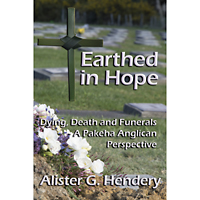The following review by Rev John Meredith appears in the June 2015 issue of Touchstone – the Methodist Church’s monthly newspaper.
“Alister G. Hendery,
Earthed in Hope.
Dying, Death and Funerals. A Pakeha Anglican Perspective.
Wellington: Philip Garside, 2014, 300 pages.
Hendery remarks that over the past four decades funeral practices in New Zealand have undergone sweeping changes. Celebrants who are not clergy conduct well over half Pakeha funerals and offer a highly personalised, life-centred alternative to churches. Although the church is no longer the chief provider of funeral ceremonies, Christian faith has a realistic approach to death and grief that is grounded in undying hope in God. Writing from an Pakeha Anglican perspective, Hendery addresses significant issues of Christian faith and practice and touches on matters relevant to all who exercise funeral ministry.
A funeral marks the ending of a human life and, as Hendery points out, people today have a wide choice in style and content of a funeral service. When a minister of the church is requested to officiate it cannot be taken for granted that the community for this funeral either understands or accepts the Christian story. Listening is a key part of the minister’s preparation. It is also important for a minister to accept that profound feelings of the loss of a physical presence cannot be assuaged by religious formulae.
At several places in the book the author stresses that whatever form the funeral takes, the most effective feature will be the embodiment of compassion by the minister. While those attending the funeral may forget what was said they will probably remember the attitude of the minister.
While a minister of the church is a spokesperson for the gospel, Hendery stresses this does not mean imposing on people. Ministers must be flexible and willing to offer guidance rather than ruling on matters such as choice of music and form of tribute.
Hendery expresses concern about the way euphemistic language may diminish the reality of someone’s death. Too often a person passes away to become the deceased. Instead, the author prefers unambiguous language. His practice of referring to someone who has died as “the dead person” indicates both respect for the person and an acceptance of reality.
The idea of closure, as it is popularly termed, is addressed thoughtfully. Writing of the pastoral care of people who are grieving, Hendery suggests that while, over time, those who have been bereaved may become reconciled to their loss, this does not mean that closure, is an appropriate end to the experience of grief. Those who are left continue to relate to those who have died through memory and abiding influence.
For those concerned with funeral ministry there is much in this book that will repay careful reflection: how God and Christian hope are presented, the avoidance of euphemisms and idealistic eulogies, ritual at and after the funeral, funerals following suicide, funerals of children and children at funerals. Hendery states: We need to be able to look death in the face and be willing to wrestle with the theological, spiritual and emotional demands that this takes. Earthed in Hope offers significant help for those who are serious about doing this.”
eBook editions of Earthed in Hope have now been reduced from NZ$14.99 to NZ$9.99.
Click here to order your PDF, Kindle or ePub edition.

